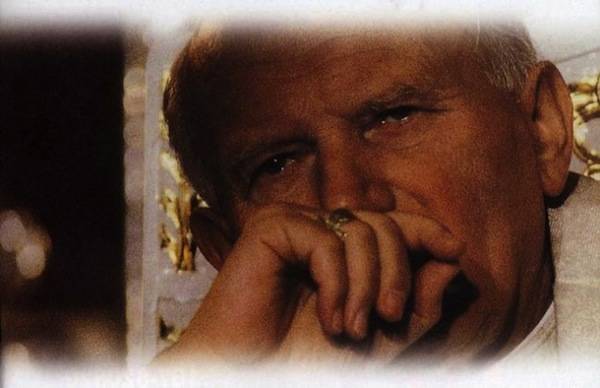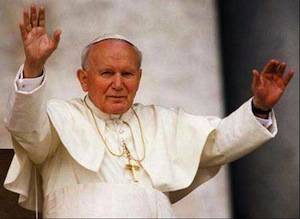The Beatified Pope
On May 1 Pope John Paul II will be beatified by Benedict XVI: in the previous ten centuries no Pope had ever so honored his immediate predecessor. The rite will be celebrated in Saint Peter, during an important day for the city of Rome that is preparing the event with over 6,500 volunteers together with transportation and police forces all ready in advance to work extra on what will surely be a great feast for the joining of culture and spirituality.
The beatification will take place during the May 1 mass in Piazza S. Pietro at 10 am, but already on April 30, from 8:30 to 10:30 pm it will be possible to take part in the great prayer vigil at the Circo Massimo held by Cardinal Agostino Vallini. The faithful will be given the opportunity to pray all night long in eight churches of the historic center along the path that connects the Circo Massimo and Piazza S. Pietro, where the Eucharistic education and confessionals will be.
After the Holy Beatification Mass held by Benedict XVI, John Paul II’s remains will be available for veneration in front of the Confession altar in the Basilica, at all times, up to the last faithful.
On May 2, at 10:30 the program will end with a Holy Mass of thanks for the Beatification of God’s Servant Karol Wojtyla. It will be three intense days after months of hard work, especially within the Basilica, and the San Sebastiano chapel, next to Michelangelo’s Pietà, where the Confession altar is placed that will hold Pope Wojtyla’s coffin. Frescos and marbles have been polished so that everything may be ready for the moving of the coffin of Innocenzo XI who had been placed there many years ago and who was moved to make place for John Paul II, defined as “great” even a few hours after his death; so “great” as to deserve an abbreviated process over the usual canonical times.
Karol Wojtyla’s was a complicated beatification process that even saw the collaboration of a group of European and South American critical theologians who thoroughly analyzed the works of the Pope, underlining every aspect, especially the negative ones, of his rule, those that could have constituted a problem for his beatification: the repression of the theology of liberation, the isolation around Bishop Oscar Romero, the condemnation of those theologians who were searching for new approaches to the aspects of sexuality, celibacy, and the role of women in the Church, the renewed centralism of the Church itself, the scandal of the Ior and having allowed the Church, although he himself had frequently denounced rapist priests, to hide the cases of sexual abuses. However, these shadows were not able to block his beatification, a first step towards sanctity, and especially his popularity. Wojtyla was admired by many, Catholics and non-Catholics, for his personality that made him a central figure of the previous century, a character who was not simply reduced to the role of Pontifex, a role that thanks to him evolved in accordance to world mutations.
He became a globetrotter, traveling around the world, to lands that no Pope had visited before, gaining notoriety all over. A strong and decisive character, Wojtyla won over the whole world from the day of his election, with his first speech as Pope: “Don’t be afraid. Open wide the doors to Christ”. Thus he spoke right after the white smoke, presenting himself to the faithful in Piazza San Pietro without knowing what to say, being reminded to simply give his blessing without saying anything, or at most simply giving a brief greeting. But instead this was the first of many revolutions Karol Wojtyla provoked in the rigid rules of the Holy See. On that occasion he spoke quite a bit, improvised, with the master of ceremonies asking him to stop, while everyone understood that there would be great changes in the Vatican, beginning with the use of “I” instead of the majestic “Us”. Such a debut made him immediately special to the masses, underlining his extraordinary communication abilities, perfectly in synch with his times.
He was a Pope who communicated, but was also an athlete, unthinkable before his accession to the papal throne, photographed while climbing mountains and skiing; a Pope used to taking a swim and who therefore had swimming pools installed in his residencies. Among the many roles of Karol Wojtyla there was that of spokesman for human rights, beyond political and cultural barriers, enough to make him defend Muslim Bosnia against the Serbian and Croatian Christian during the was in Yugoslavia, but also to recognize the State of Israel and at the same time condemn Sharon’s wall. He was destined to cross barriers that until then had been considered impassable, such as the entrance to the Synagogue in Rome, the first to be visited by a Pope since the apostle Peter. This was repeated at a mosque and a Buddist temple in Thailand, promoting interreligious dialogue, inviting religious leaders of around the world to Assisi to pray for peace and exhorting everyone to coexist and respect different men and religions of the world. Already in 1979, with the Redemptor Hominis encyclical letter, Pope Wojtyla had stated that religious freedom is a human right and that the Church was setting itself as its “guardian”. Those were innovative concept for the time, premonition of what was about to happen.
All his Pontificate was in wait for the Jubilee of 2000, and he loved to repeat, “the Church should enter the third millennium purified”. This brought forth his pleas for forgiveness regarding errors and horrors committed in Christ’s name throughout the centuries, with an unusual image of a Pope no longer on a throne, but on his knees, aware of the notion that blood cannot be spilled abusing the divine name. Karol Wojtyla, also, had played a decisive role in the destruction of Communism in East Europe, awakening consciences in the name of religious and national values.
Karol Wojtyla, his closest collaborators care to remember, looked his interlocutors straight in the eyes, establishing a contact that went way beyond pure formality and this research for contact with “the other” is at the base of his “corporeal theology” that probably no other Pope will be able to re-propose with such efficacy. Wherever he went, but especially in Africa and Oceania, he didn’t think twice about breaking the rules, hugging half naked children and bare-breasted women. A spontaneity that made him popular and beloved everywhere. And the body, its communication, became, in his final moments, a way to convey fearlessness in the face of infirmity and that a gravely ill man may live his disease with dignity. And at that moment of weakness, once again Karol Wojtyla communicated to the world his being a simple man of flesh and bones, becoming the living representation of a humanized Church, with nothing to hide. On the contrary, it became more of a witness of Christ through its pain, with the impossibility of speaking as before and yet communicating in a disruptive manner with his silence and suffering. After his death, many perceived the presence of Karol Wojtyla even at his funerals when the Decan, Cardinal Ratzinger, who would become the next Pope, mentioned the celestial presence of the Pope’s sould while the wind rustled in the cloaks of the Cardinals and the pages of the Gospel on the coffin. On May 1, during the celebration Karol Wojtyla himself had wanted to dedicate to Divine Mercy, John Paul II will become Blessed, and will linger on in the hearts of the thousands of faithful that have never forgotten him and that already consider him a Saint.









































i-Italy
Facebook
Google+
This work may not be reproduced, in whole or in part, without prior written permission.
Questo lavoro non può essere riprodotto, in tutto o in parte, senza permesso scritto.